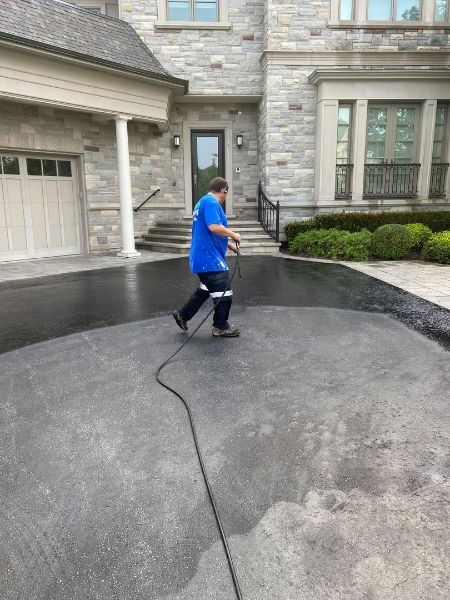Cold Mix Asphalt Vs. Hot Mix Asphalt: Which Is Right for You?

Composition Differences
Cold mix and warm mix asphalts differ substantially in their composition, with unique features that impact their performance and applications. Cold mix asphalt is generated by emulsifying the asphalt binder with water and an emulsifying agent before mixing it with accumulation. This approach permits the asphalt to be convenient at reduced temperature levels, making it suitable for short-lived repairs and for usage in colder weather condition problems. Warm mix asphalt, on the various other hand, is manufactured at high temperatures, normally in between 300-350 ° F, which helps to achieve much better compaction and a much more sturdy last item. The warm mix asphalt manufacturing procedure entails heating the aggregate and asphalt binder individually before integrating them at the asphalt plant.
Moreover, chilly mix asphalt has a tendency to be much less dense and much more versatile than hot mix asphalt. This flexibility makes it better suited for areas with greater degrees of activity, such as driveways or roadways with hefty web traffic. On the other hand, hot mix asphalt is known for its high resilience and resistance to rutting and breaking, making it a preferred selection for freeways and high-traffic roadways where longevity is essential.
Installation Refine Differences
The procedure of setting up cool mix and hot mix asphalt shows noteworthy variances in their procedures and demands. In contrast, hot mix asphalt necessitates a much more sophisticated setup process. Due to the heating needs, warm mix asphalt installments are commonly brought out by specialists with specialized devices, guaranteeing an extra long-term and structurally audio result.
Longevity and Long Life Factors
When considering asphalt choices, resilience and longevity are vital aspects to examine for long-term sidewalk performance. Warm mix asphalt (HMA) is known for its remarkable toughness and long life.
In regards to long life, HMA typically outshines CMA as a result of its superior stamina and resistance properties. HMA pavements have a longer life span, requiring less constant fixings and upkeep, which can translate to set you back savings over time. In addition, HMA pavements are much more quickly customizable to fulfill particular project requirements, even more boosting their resilience.
Cost Factors To Consider
Considering the financial ramifications is a vital aspect when examining the selection between hot mix asphalt (HMA) and chilly mix asphalt (CMA) for pavement projects. While the preliminary expense of hot mix asphalt is normally more than that of cool mix asphalt, HMA typically gives an extra affordable remedy in the long run as a result of its superior longevity and durability. HMA is known for its capacity to endure heavy web traffic lots and severe climate condition, reducing the demand for regular fixings and upkeep. On the other hand, cool mix asphalt is more inexpensive upfront however might require more frequent patching and resurfacing, leading to higher upkeep expenses in time.
Along with product costs, it's necessary to take into consideration the costs associated with setup and maintenance when comparing HMA and CMA. HMA usually requires specific tools and knowledgeable labor for correct setup, which can impact overall task costs. Conversely, CMA is less complicated to collaborate with and can commonly be applied utilizing simpler methods, potentially reducing installation expenditures. Ultimately, the choice in between HMA site and CMA need to take into consideration not simply the preliminary price however likewise the long-lasting financial effects to establish the most affordable option for the particular pavement task.
Environmental Impact Contrast
Comparison of the environmental effects between warm mix asphalt (HMA) and cold mix asphalt (CMA) reveals distinct differences in sustainability practices. HMA manufacturing calls for high temperature levels, leading to raised energy intake and greenhouse gas emissions.
Furthermore, the use of CMA usually entails reusing existing asphalt sidewalk, promoting source preservation and lowering the amount of waste sent to garbage dumps. This more tips here reusing facet further improves the sustainability of CMA compared to HMA. On the whole, when taking into consideration the environmental influence, CMA becomes a much more ecologically sustainable option due to its reduced power needs, minimized emissions, and the potential for reusing existing materials. By deciding for CMA over HMA, roadway construction projects can contribute favorably to environmental preservation efforts.
Conclusion
Finally, the choice in between cool mix asphalt (CMA) and hot mix asphalt (HMA) depends upon additional resources different factors such as composition, installation procedure, sturdiness, long life, price, and environmental impact. cold mix asphalt. While CMA supplies a quick and affordable remedy for minor repairs, HMA ensures premium longevity and durability for rush hour areas. Think about these elements very carefully to establish which type of asphalt is the ideal option for your paving needs

Considering the economic effects is a critical aspect when evaluating the choice in between hot mix asphalt (HMA) and chilly mix asphalt (CMA) for sidewalk jobs. While the first expense of hot mix asphalt is typically higher than that of cool mix asphalt, HMA typically provides an extra cost-efficient service in the long run due to its superior durability and durability. cold mix asphalt.Comparison of the environmental effects in between hot mix asphalt (HMA) and chilly mix asphalt (CMA) exposes distinct differences in sustainability methods.In conclusion, the choice between cold mix asphalt (CMA) and warm mix asphalt (HMA) depends on various aspects such as make-up, installment procedure, longevity, durability, expense, and environmental influence
Comments on “Lengthen Pavement Life-span: Innovative Cold Mix Asphalt Sealing”